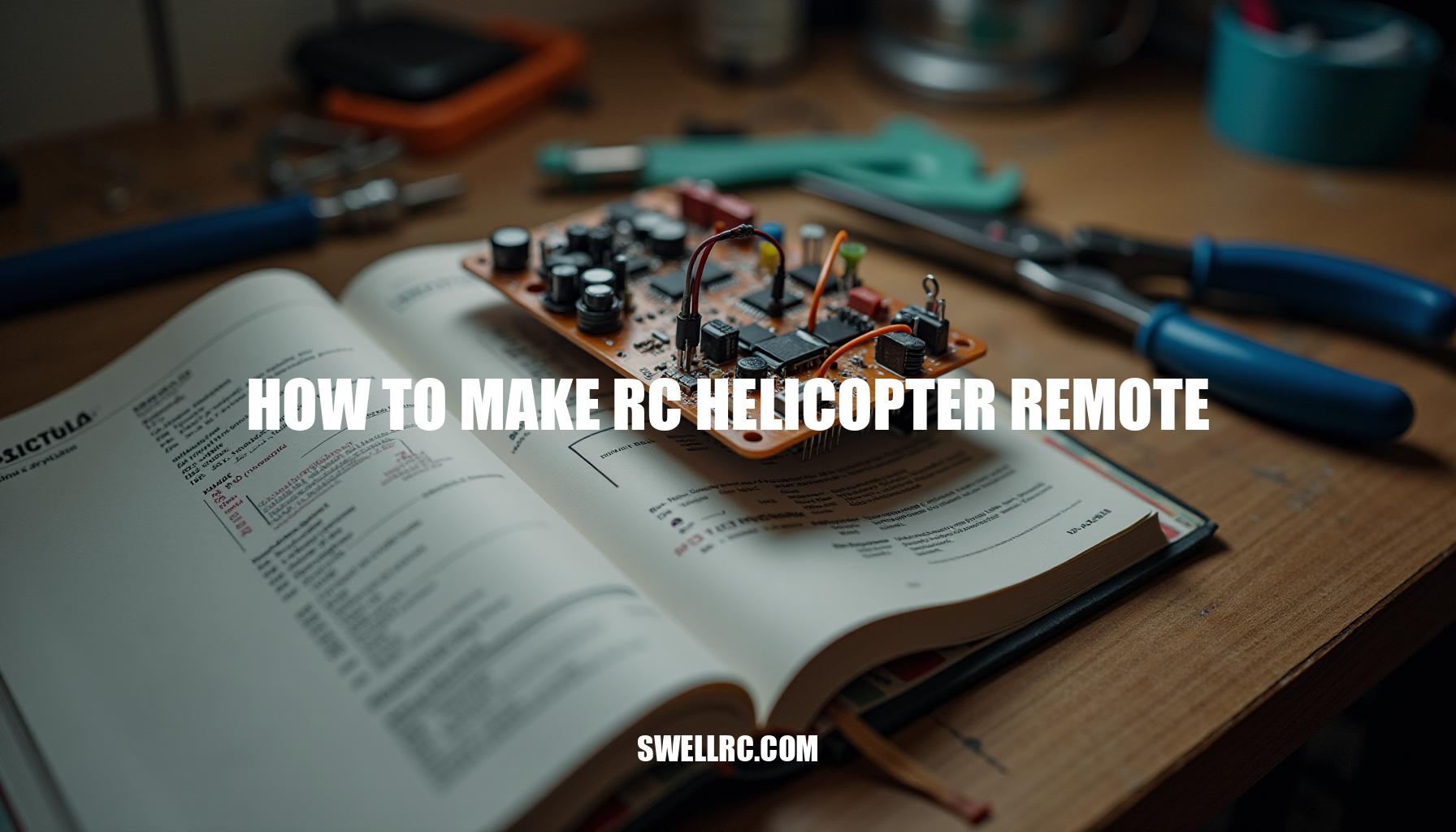How to Make an RC Helicopter Remote: A DIY Guide
After countless flights controlling my RC helicopter, a curious thought struck me: what if I could build the remote control system myself—and truly understand every signal passing between my thumbs and the rotors? This hands-on journey would mean learning to assemble hardware from scratch, mastering basic soldering skills, diving into microcontroller programming, and patiently testing and pairing the transmitter safely within local radio regulations. Whether you’re a hobbyist eager to explore a DIY RC project or looking to craft a homemade RC helicopter remote setup, this guide promises a clear, repeatable path from initial stick movement to rotor response.
Along the way, we’ll identify the best components for DIY RC remote builds and decode the intricate commands of an RC controller. Ready to embark on this discovery-driven adventure? For a quick overview of gear options before we dive in, check out this handy primer on helicopter RC remote control.
Understanding How RC Helicopter Remotes Work
Understanding how RC remotes work starts with the simple yet fascinating conversation between the transmitter and receiver. When you move a stick on your controller, you’re physically changing an analog voltage. This analog signal is then read by a microcontroller inside the transmitter, which converts it into digital channel values.
These values are then processed and packaged into digital data packets, incorporating checksums for error detection and sometimes telemetry information to give real-time feedback.
These data packets are transmitted over a 2.4GHz transmitter module, which operates on the 2.4GHz frequency band known for low interference and wide adoption. To ensure resilience against signal degradation, techniques like Frequency Hopping Spread Spectrum (FHSS) and Direct Sequence Spread Spectrum (DSSS) are employed. These methods help the signal ‘jump’ between frequencies or spread across a wide band, greatly reducing the chances of interference from other devices.
The high frequency enables compact antenna designs and robust error checking, which are essential in maintaining a stable communication link.
At the receiver’s end, the process reverses: it decodes the digital packets, extracts channel data, then outputs signals to control servos, Electronic Speed Controllers (ESCs), and gyro or flight controllers. While the sticks you handle are analog, the transmission is purely digital, bridging sensor input and mechanical response through signal processing and frequency modulation.
For actuator control, standard servos interpret signals via pulse width modulation (PWM). They expect pulses roughly between 1000–2000 microseconds at around 50 Hz. ESCs for motors typically use the same pulse width range to control throttle, while advanced flight controllers often prefer protocols like SBUS or CRSF for quicker response times and lower latency, critical in precise gyro stabilization.
Safety is paramount.
The receiver includes a failsafe mode deciding what happens if communication is lost, such as cutting throttle to avoid accidents, holding the last command, or setting preset safe values.
- Stick movement produces an analog voltage.
- Microcontroller converts analog to digital channel values.
- RF module sends spread spectrum packets at 2.4GHz.
- Receiver decodes packets, outputs PWM/SBUS to servos and ESCs.
- Servos respond to PWM pulses (~1000–2000 µs at 50 Hz).
- ESCs control speed using PWM; flight controllers prefer low-latency protocols.
- Failsafe modes protect against signal loss.
For a detailed explanation of the encoding, packet structure, and protocols involved in transmitter and receiver communication, you can check out this excellent resource: How RC Controllers Work.
Essential Components You’ll Need
To build a reliable and customizable RC helicopter transmitter or controller, assembling the right core parts with practical sourcing tips tailored to your budget and ambition is essential. Below is a comprehensive list incorporating key components and advice on obtaining them efficiently:
- Microcontroller Board: Choose from popular options like Arduino Pro Micro or Nano for beginners, STM32 “Blue Pill” for more computing power, or ESP32 if you want built-in Wi‑Fi/Bluetooth capabilities for advanced features. These microcontrollers form the brain of your RC circuit board and can be sourced from major electronics suppliers or reputable online marketplaces.
- RF Link and Transmitter Module: Pick one RF path based on your DIY enthusiasm or integration needs. For a hands-on approach, the nRF24L01+ module with PA/LNA offers a custom protocol fine for learning RF communication. Alternatively, hobby ecosystem modules supporting multiple protocols like CC2500, A7105, CYRF, or multi-protocol ExpressLRS/FrSky modules provide robust compatibility.
Ensure the transmitter module is paired with a properly matched 2.4GHz RF antenna featuring a coax pigtail; antenna orientation critically influences signal quality.
- Gimbals/Joysticks and Potentiometers: Opt for two high-quality hall-effect gimbals or joysticks to achieve smooth and precise control, essential for handling your RC helicopter. Incorporate potentiometers or sliders as trims for finer adjustments. Many suppliers offer these components as modules or individual parts, but it’s wise to buy spares due to their fragile nature.
- Switches and Knobs: Include 2–3 position switches for managing flight modes, arming, and rate changes. These tactile components impact usability and should fit comfortably within your casing.
- Power Supply: Use a 2S Li‑ion or LiPo battery pack paired with a clean 5V/3.3V regulator to supply the microcontroller and other electronics reliably. Incorporate a fuse and reverse-polarity protection circuits on your RC circuit board for safety and component longevity. Quality regulators and power protection modules are widely available from electronic component distributors.
- Enclosure/Casing: A well-designed enclosure is critical not only for protecting components but for ergonomics. You can 3D-print custom shells or repurpose existing cases, making sure the stick spacing suits your hands. Consider ventilation and robust mounting points for switches, joysticks, and your display.
- Display and Feedback (Optional): OLED displays provide convenient menus and telemetry data, while buzzers or haptic motors offer alerts and notifications. These components enhance usability and can be integrated once the core system is stable.
- Receiver on the Helicopter: It must match your chosen RF link and support output formats like PWM, SBUS, or CRSF compatible with your flight controller and servos. Correct selection ensures seamless gyro stabilization and ESC management during flight.
For enthusiasts interested in fabricating their own control boards, this guide covers detailed layout and power conditioning essentials to design a robust RC circuit board.
Tips for smoother building: Start with a simple setup consisting of two gimbals and one switch, expanding complexity over time. Always purchase two units of small or fragile parts like joysticks and voltage regulators to prevent shipping delays hindering your build. Finally, always verify your region’s radio transmission regulations before powering up your transmitter module and RF antenna to ensure compliance.
Step-by-Step Process: Building the RC Helicopter Remote
Embarking on a DIY RC project to build your own 2.4GHz transmitter involves a meticulous, stepwise approach. Here’s a numbered, test-as-you-go plan from schematic to first transmission, with quick fixes after each milestone to ensure smooth progress and functional success.
- Plan channels and features: Start by defining your control channels – throttle, yaw, pitch, roll, plus auxiliary channels such as arm and flight mode. Sketch a clear front panel layout and create wiring diagrams. This stage establishes your foundation and avoids wiring snafus later.
- Prototype electronics: Breadboard the microcontroller, connect joysticks (gimbals) to ADC inputs, and switches to digital pins. Integrate voltage regulators to ensure clean 5V/3.3V rails, vital for stable MCU and RF performance. Confirm power rails with a multimeter before proceeding.
- Firmware basics: Program the microcontroller to read joystick inputs and map them to standard 1000–2000 µs channel pulse width values, crucial for PWM calibration. Implement a deadband and exponential response curves for smoother control. Use serial output to print values for sanity checks.
(A quick fix: I once mis-pinned a gimbal, causing reversed pitch—debugging this by adjusting mappings made the controls feel accurate again.)
- Packetization: Develop a compact channel data frame with a checksum for data integrity. If handing off to an external module, generate PPM/SBUS/CRSF signals from the MCU. This step ensures reliable communication formats compatible with the flight receiver system.
- First RF test: Set transmission at low power across the desk. Use a second microcontroller as a receiver to decode signals and verify channel integrity. This is your first link between transmitter and receiver, confirming the core of your transmitter build is functional.
- Ergonomics and enclosure: Securely mount gimbals, route the antenna away from power wiring to prevent interference, and strain-relieve battery leads. Attach heat sinks to regulators to avoid thermal issues. This improves user interaction and device longevity.
- Range and latency refinement: If your RF module supports auto-acknowledgments and retries, enable those. Tune packet rate (typically 100–200 Hz) for responsive control. Optimize antenna placement for maximum range and minimal noise—especially important for ESC control and overall flight stability.
- Final assembly: Add labels to controls, trims, and a buzzer for status alerts. Save default endpoint settings and failsafe parameters into EEPROM or flash memory to preserve configuration. This completes your robust programming microcontroller and wiring setup.
To connect your newly built transmitter to an airframe, review how the remote interfaces with the craft’s flight system and powertrain as detailed in this guide. Understanding joystick wiring, ESC control, and radio communication protocols ensures seamless integration of your transmitter into the complete RC setup.
Pairing and Testing Your Remote with the Helicopter
Achieving a clean first hover begins with a meticulous binding process—ensuring your transmitter and receiver pairing is flawless. Start by putting the receiver into bind mode, either via a dedicated button or a power-on sequence, then instruct your transmitter to send a bind packet. Once bound, power-cycle the system to confirm a persistent link, which is critical for optimal signal precision.
Remember, keeping antennas perpendicular enhances reception diversity.
Next, focus on calibrating the sticks. Zero trims, set endpoints or sub-trims accurately, and verify channel directions within your flight controller. Proper setup here guarantees that each control input translates precisely, paving the way for balanced flight.
Moving on to throttle calibration, if your model uses direct PWM, calibrate the ESCs by setting the throttle range carefully. For flight controller-managed models, adjust minimum and maximum throttle settings in the FC to ensure responsiveness without surprises in power delivery.
Gyro setup plays a pivotal role in maintaining gyro balance. Verify your arming logic and select a gentle beginner rate suitable for initial flights.
Confirm that your failsafe system effectively cuts throttle in case of signal loss, forming a crucial part of your failsafe setup. This conservative approach is vital to avoid accidents during your maiden hover.
Before taking off, implement a thorough testing routine: start with props off or rotor head disarmed; check channel values via telemetry if available; perform a short-range hover test; and carry out distance checks in an open field setting. To minimize latency, observe stick-to-servo response times, adjusting configurations as needed for real-time control.
Here’s a handy checklist for your pre-flight preparation:
- Bind receiver and transmitter; confirm persistent link after power cycling
- Calibrate sticks with zero trims, endpoints, and correct channel directions
- Set throttle range via ESC calibration or flight controller
- Verify gyro arming logic, set beginner rates, and configure failsafe throttle cut
- Perform a testing routine starting without props, progressing to hover and distance tests
- Maintain antenna orientation to maximize signal diversity
- Log RSSI and packet loss if telemetry is available for ongoing monitoring
For deeper insights, consult specialized guides on signal syncing specifics for helis and the binding logic explained through RC car syncing.
Integrating these steps will enhance your signal precision, throttle calibration, gyro balance, latency reduction, and failsafe setup, setting you up for that perfect first hover.
Troubleshooting and Fine-Tuning Performance
When troubleshooting RC issues, it’s normal to hit common snags like signal dropouts, servo jitter, or range limitations. Each challenge offers a chance to understand how these tiny systems truly work, so stay encouraged and tackle one variable at a time. Here’s a quick reference table to help you diagnose and fix frequent problems efficiently:
| Problem | Likely Cause | Solution |
|---|---|---|
| Signal dropouts | Antenna placement or RF power noise | Re-orient antennas, add LC filtering to RF supply, separate RF wiring from motor/ESC wires |
| Servo jitter | Ground loops or noisy input signals | Add input filtering and proper pull-ups; slow PWM update rate if buzzing occurs |
| Short range | Incorrect antenna or RF module version; enclosure blocking RF | Verify correct 2.4GHz antenna, check PA/LNA version, ensure no RF blockage by frame |
| Brownouts/reboots | Undersized regulator or insufficient capacitors | Use higher-current regulator, add bulk/tantalum caps near RF and MCU, test under worst-case load |
| Direction/channel mix mistakes | Incorrect mapping or reversing done both on TX and FC | Confirm mapping, reverse only in one place (TX or flight controller) |
Additionally, mechanical issues can mimic radio malfunctions—if behavior seems linked to your airframe rather than radio signals, check a dedicated repair guide like this one on fixing RC helicopters.
Remember, effective troubleshooting RC involves understanding the interplay between signal dropouts, servo jitter, range limitations, power regulation, EMI, and calibration. Each glitch is simply feedback from the system—keep logs, be methodical, and you’ll level up your diagnostic skills quickly!
Advanced Options: Smartphone and Universal Controls
For builders eager to push the boundaries of remote control technology, integrating Android RC control opens exciting avenues. By adding a Bluetooth module or Wi‑Fi module to your transmitter or helicopter, you can map on-screen sticks directly to channel packets, allowing smartphone interfaces to seamlessly pilot your models. Explore the starter roadmap for implementation here: Android control guide.
Beyond single-model management, adopting a universal controller strategy empowers you to effortlessly handle multiple models and protocols. Utilizing a universal RC hub or a multi-protocol module lets you switch between different vehicle types like helicopters, quads, and cars without swapping gear. For design inspiration and practical circuit examples, see the comprehensive guide at universal RC control.
Programmable remotes add another layer of sophistication. By mastering binding procedures, model memories, and channel mapping—as detailed in studies of programmable car remotes—you can customize controls to suit each aircraft’s unique dynamics. This cross-compatibility enhances user experience and tuning flexibility.
Learn more from the tutorial at programming remotes.
To truly inspire upgrades, consider integrating these path-defining features:
- Telemetry pages: Display real-time voltage, RSSI, and temperature data via an OLED screen or phone app for immediate feedback.
- Low-latency links: Experiment with ExpressLRS or similar protocols by outputting CRSF/SBUS signals from your MCU to the RF module for responsive control.
- Custom model profiles: Create dedicated settings for heli, quad, and car models featuring trims, rates, and mix adjustments tailored to each platform.
Embracing these advancements not only future-proofs your builds but also positions you at the forefront of the RC innovation curve, blending cross-compatibility and intelligent design for next-generation remote control experiences.
Conclusion – Why Building It Yourself Is Worth It
Celebrating the journey from initial curiosity to holding a fully functional transmitter in your hands truly highlights the essence of a DIY RC project. Every step—from wiring circuits and coding firmware to testing each component—builds a foundation of learning electronics that transforms theories into tangible success.
What worked best was the methodical approach to hobby craftsmanship, where patience and attention to detail paved the way for a transmitter build success. This process not only boosted confidence but also deepened insight into how each layer integrates to bring your RC helicopter to life.
Looking ahead, the possibilities are thrilling.
You might consider upgrades such as:
- Improved range modules to extend flight distance
- Enhanced gimbal assemblies for smoother control
- Integrating telemetry for real-time data feedback
For those inspired to push further, SwellRC offers an array of deep‑dive guides to support your next adventures in RC helicopter mastery.
After those late-night soldering sessions and countless reset loops, witnessing that first stable hover is nothing short of magical — a testament to dedication and craftsmanship that makes every minute spent genuinely worthwhile.
Frequently Asked Questions
- How does a remote control communicate with an RC helicopter?
Your sticks create analog voltages that a microcontroller samples and packs into a digital frame. A 2.4GHz RF module transmits those frames; the receiver decodes them and outputs PWM/SBUS/CRSF signals to servos, ESCs, and the flight controller. Error checking, hopping/spread spectrum, and failsafe keep the link reliable. - What materials are needed to make an RC helicopter remote?
A microcontroller (Arduino/STM32/ESP32), RF link (nRF24 or a hobby transmitter module), two gimbals, switches/knobs, voltage regulators, battery (2S Li‑ion/LiPo), 2.4GHz antenna, enclosure, wiring/PCBs, and basic tools (soldering iron, multimeter, programmer). - Can I use an Android phone as a remote for my RC helicopter?
Yes. Add a Bluetooth or Wi‑Fi bridge that converts app joystick inputs into RC channel packets for your receiver or flight controller. Latency and range depend on the modules and app design; start with short‑range tests and proper failsafe. - How do I program a new remote for my RC model?
Define channel mapping, endpoints, and failsafe in your transmitter firmware, then bind to the receiver. Calibrate sticks and, if needed, ESCs. Save a model profile per aircraft to keep mixes and modes organized. - Why isn’t my homemade remote syncing with the helicopter?
Check that both sides use the same protocol and frequency, the receiver is in bind mode, and antennas are correctly oriented. Verify power stability, packet format, and channel order. Start with props off and confirm channel values in the flight controller. - How do RC helicopter circuits work?
The receiver routes decoded channel signals to a flight controller, which blends gyro/accelerometer data with your inputs to drive servos and the ESC. Power regulation and filtering keep sensors and RF clean, while PWM/SBUS/CRSF carry the control data.



